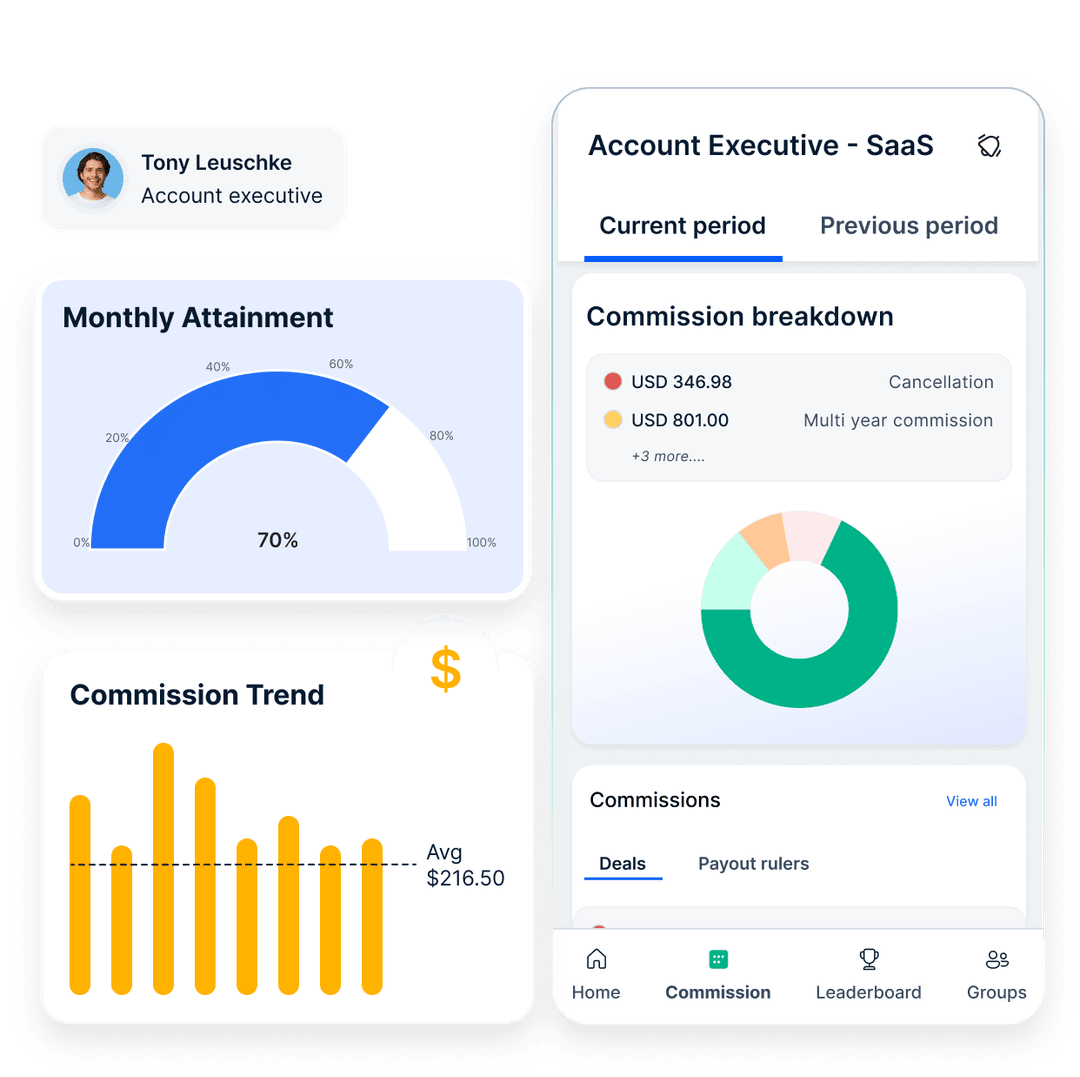20 SMART Sales Goals Examples to Set for Your Business in 2025
Struggling to set the right sales goals? These 20 SMART sales goals examples will help you create clear, measurable targets that drive business growth and improve your team’s performance.
On this page
Sales is a tough game—persistence, strategy, and goal-setting make all the difference. A Baylor University study found that it takes around 209 cold calls to land a single appointment or referral, while Statista reports that conversion rates across industries range from 2.46% to 3.26%. Without a clear plan, sales efforts can easily fall short.
That’s where SMART sales goals come in. By setting Specific, Measurable, Achievable, Relevant, and Time-bound targets, businesses can improve focus, track progress, and drive revenue growth. With 66% of sales employees spending their time on administrative tasks (Salesforce), defining the right goals can help optimize performance.
In this guide, you’ll find 20 SMART sales goals examples to keep your sales strategy structured and results-driven. These examples of sales goals will help you align sales efforts with business objectives, making success more attainable.
What are SMART sales goals?
SMART sales goals provide a structured approach to setting and achieving sales targets. Instead of vague objectives like “increase sales,” SMART goals break down targets into clear, actionable steps that sales teams can follow. The SMART framework ensures that goals meet five essential criteria:
- Specific: Goals should be well-defined and focused. Instead of saying, “Improve sales,” a SMART goal would be, “Increase monthly sales by 15% through outbound prospecting.”
- Measurable: Progress should be quantifiable. A goal like “Close more deals” is vague, while “Close 10 new deals per month” provides a clear metric for success.
- Achievable: Goals must be realistic based on available resources and market conditions. Setting a goal to “Increase revenue by 500% in one month” may not be feasible, but aiming for a 10% increase is more practical.
- Relevant: Sales goals should align with overall business objectives. If the company is focusing on customer retention, a relevant goal could be, “Increase upsell revenue by 20% in the next quarter.”
- Time-bound: Goals should have a deadline to create urgency and accountability. Instead of saying, “Grow the customer base,” a SMART goal would be, “Acquire 50 new customers within the next 90 days.”
Using SMART sales goals examples, businesses can set clear targets, track progress effectively, and ensure that their sales efforts lead to measurable growth. This method keeps teams focused, motivated, and aligned with long-term business success.
Factors to consider to create SMART sales goals for the business
SMART is a futuristic strategy that most pioneers of sales swear by. But before setting your sales division up for the strategy, you might want to consider the factors that are to be involved.
When creating SMART sales goals for your business, it's important to consider several factors to ensure their effectiveness and alignment with your overall sales strategy.
Here are some key factors to keep in mind:
1. Business objectives
We can all agree to the fact that the ultimate objective of sales is to better the overall business and drive it forward. Align your sales goals with your broader business objectives. Consider how your sales efforts contribute to the overall growth, revenue targets, market expansion, or customer retention goals of your organization. This ensures that your sales goals are relevant and impactful.
2. Historical performance
Much can be figured out from simply looking at the past figures and numbers. Analyze your past sales performance to identify areas for improvement and set realistic goals. Consider factors such as revenue trends, conversion rates, average deal size, and customer retention rates. Use this data as a baseline to set measurable targets that challenge your team while remaining achievable.
3. Market conditions
Analyzing the battleground gives the contender an extra edge of advantage. Take into account the current market conditions and industry dynamics when setting your sales goals. Evaluate factors such as market growth, competitive landscape, customer preferences, and economic trends. This will help you set realistic goals that consider external factors that may impact sales performance.
4. Sales team input
Your sales team are the real heroes who venture out every single day and make the magic happen. Involve your sales team in the goal-setting process. Seek their input and insights on the feasibility of the goals, potential challenges they foresee, and strategies to achieve them. Involving your team creates a sense of ownership and increases their commitment to achieving the goals.
5. Sales cycle and pipeline
Analyzing the overall process by looking at the sales cycle and the pipeline gives businessmen a look at the bigger picture. Understand the typical sales cycle length and the stages in your sales pipeline. Consider how long it takes from initial contact to closing a deal, and evaluate the conversion rates at each stage. This understanding helps you set time-bound goals that account for the sales cycle and the progress within the pipeline.
6. Available resources
It is important to set your priorities right - especially when it comes to business resource management. Assess the resources available to support your sales efforts, including the size and capabilities of your sales team, marketing initiatives, technology tools, and budget. Ensure that your goals are realistic and can be achieved with the available resources.
7. Industry benchmarks
It is always a great idea to compare your business with benchmarks set by predecessors. Research industry benchmarks and best practices related to sales performance metrics. Compare your current performance against industry standards to identify areas for improvement. Set goals that push you to exceed benchmarks and stay ahead of your competition. Learning from the best is always a safe bet.
8. Continuous measurement and review
Continuous analysis helps in staying on the right path and realigning the process to the original goal. Establish a process for measuring and reviewing your sales goals regularly. Monitor progress, track key performance indicators, and make adjustments as needed. Regular reviews allow you to identify bottlenecks, recognize achievements, and make informed decisions to optimize your sales strategy.
20 SMART sales goals examples for better sales performance
Setting clear objectives is key to improving sales performance. These SMART sales goals examples provide a structured approach to goal-setting, ensuring your targets are specific, measurable, achievable, relevant, and time-bound. With well-defined goals, your sales team can stay focused, track progress, and drive better results.
1. Increase monthly sales revenue by X percent
The monthly sales figure is the most important parameter of all for any business. Increase your monthly sales revenue by a specific percentage that is challenging yet achievable. This goal helps drive overall business growth and ensures a measurable impact on your bottom line.
2. Acquire X number of new customers per month
The number of customers a business has is directly proportional to its reputation and visibility in the market. Set a target for the number of new customers you aim to acquire each month. This goal focuses on expanding your customer base and generating new business opportunities.
3. Achieve X percent growth in repeat sales
Repeat sales means that your customers are repeating their purchase, which means that they love your product/service. Set a goal to increase the percentage of repeat sales from existing customers. This encourages customer loyalty and maximizes the lifetime value of your client relationships.
4. Improve sales conversion rate by X percent
The sales conversion rate denotes how well your sales team is able to convert their potential customers into real customers. Set a goal to enhance your sales conversion rate, which measures the percentage of leads that turn into paying customers. Improving your conversion rate optimizes your sales process and increases efficiency.
5. Increase average deal size by X percent
Another way to increase revenue besides working on the number of customers is by increasing the amount or the transaction value of the customer. Aim to increase the average value of each sales transaction by a specific percentage. This goal focuses on upselling, cross-selling, or negotiating higher-value deals.
6. Reduce sales cycle length by X days
The longer the sales cycle length, the longer it is going to take to increase the revenue. Set a target to reduce the time it takes to close a sale. Shortening the sales cycle enhances productivity, increases revenue potential, and allows for a more efficient use of resources.
7. Improve customer satisfaction rating to X
Satisfied customers mean that your products and services are doing great in the market and increases the chances of repeat sales. Set a goal to achieve a specific customer satisfaction rating, based on surveys or feedback. Improving customer satisfaction enhances retention, referrals, and long-term business success.
8. Increase sales team productivity by X percent
The sales team productivity is a definite way to increase the sales turnover and therefore increase the revenue. Set a goal to improve the productivity of your sales team by a certain percentage. This could be measured by factors such as the number of calls made, meetings scheduled, or deals closed.
9. Expand market share by X percent
The market share of the product directly denotes the brand visibility and the brand acceptance amongst the customers. Set a goal to increase your market share within a specific target market or industry. This goal focuses on capturing a larger portion of the market and outperforming competitors.
10. Enhance sales forecast accuracy to X percent
Increasing the sales forecast accuracy helps in making the right decisions and allocating the right resources for the job. Set a goal to improve the accuracy of your sales forecasting. Accurate forecasting helps with resource planning, budgeting, and decision-making.
11. Increase cross-selling opportunities by X percent
Cross-selling opens up a whole new arena for the business and the customers and lets them experience products and services across the product platform of the brand. Set a goal to increase the number of cross-selling opportunities within your existing customer base. This goal promotes upselling and maximizes revenue potential from each client.
12. Improve sales team training and development
Your sales team are your soldiers in the warfield. Investing in their training and development is absolutely necessary. Set a goal to enhance the skills and knowledge of your sales team through training programs, workshops, or coaching. This goal focuses on continuous improvement and ensures a high-performing sales team.
13. Develop X number of strategic partnerships
Partners, be it in the same product or the service category or using social media such as Influencers and bloggers - are the new age way to improve sales. Set a goal to establish a certain number of strategic partnerships with complementary businesses. Strategic partnerships expand your reach, access new markets, and create mutually beneficial collaborations.
14. Increase customer retention rate by X percent
If people think sales is hard, Retaining is harder. Customer retention is directly proportional to your customer satisfaction score. Set a goal to improve your customer retention rate by reducing churn and increasing customer loyalty. This goal emphasizes the importance of nurturing existing customer relationships.
15. Achieve X percent increase in sales from referrals
Referrals are an important and yet untapped resource that most businesses neglect. Set a goal to increase the percentage of sales generated through customer referrals. This goal focuses on leveraging satisfied customers as advocates for your business and tapping into the power of word-of-mouth marketing.
16. Attain X number of upselling opportunities
Upselling is key to improving your average customer value and the overall sales value. Set a target for the number of upselling opportunities you aim to identify and pursue with existing customers. This goal encourages sales representatives to uncover additional needs and offer relevant upgrades or add-ons.
17. Improve sales team collaboration and communication
Your sales team needs to be efficient in collaborating and communicating amongst each other to improve their overall productivity. Set a goal to enhance collaboration and communication among your sales team members. This can be achieved through regular team meetings, effective use of communication tools, and fostering a culture of knowledge sharing.
18. Expand into X new geographic markets
Expanding into new markets opens up new horizons for your brand to venture into and acquire all new customer bases. Set a goal to enter and establish a presence in a specific number of new geographic markets. This goal focuses on geographic expansion, allowing you to tap into untapped customer segments and drive business growth.
19. Increase sales qualified leads (SQLs) by X percent
Sales qualified leads turn into potential customers and eventually into real customers. Set a goal to generate a higher percentage of sales qualified leads. This involves optimizing your lead generation and qualification processes to ensure that your sales team focuses on leads with the highest potential to convert into customers.
20. Attain X percent increase in sales team closing ratio
Closing deals is the ultimate challenge; therefore, focussing on increasing the sales team closing ratio is a no-brainer. Set a goal to improve the closing ratio of your sales team, measuring the percentage of opportunities that result in closed deals. This goal encourages sales representatives to become more effective in converting opportunities into customers.
Achieve your SMART sales goals with Compass
Setting SMART sales goals is one thing—tracking and achieving them is another. That’s where Compass comes in. As a powerful sales performance management software, Compass helps businesses set, monitor, and optimize their sales targets with real-time insights and automation.
Whether you’re aiming to increase revenue, improve conversion rates, or boost customer retention, Compass ensures your team stays aligned with clear, measurable objectives.

How Compass helps you hit your SMART sales goals:
- Real-time goal tracking: Get instant insights into progress on SMART sales goals examples with live dashboards.
- Automated performance monitoring: Identify gaps and adjust strategies proactively.
- Incentive & commission management: Motivate your sales team with automated rewards for goal achievement.
- Custom goal setting: Define personalized, data-driven targets that align with your sales strategy.
- Seamless CRM & tool integrations: Connect Compass with your existing sales tech stack for effortless tracking.
With Compass, you don’t just set SMART sales goals—you hit them. Keep your team motivated, streamline sales performance, and drive consistent revenue growth with data-backed decision-making.
👉 Ready to turn your SMART sales goals into real results? Explore Compass today!
Conclusion
Setting SMART sales goals is essential for driving success and growth in your business. With the help of SMART goals, you can align your sales efforts with your overall business objectives, track your progress effectively, and motivate your sales team toward achieving tangible results.
With these 20 foolproof examples, you can inspire to set your own SMART sales goals customized to your unique business needs and priorities. Remember to regularly review and adjust your goals as necessary, leveraging them as a roadmap for continuous improvement and sales success.













